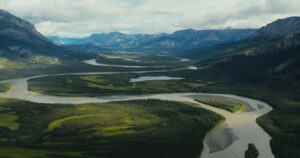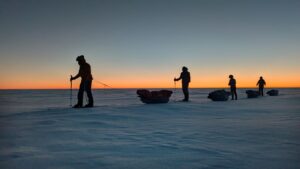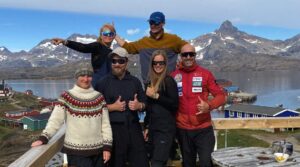French “professional explorer and crazy dad” Loury Lag has announced his newest project: a solo kite-skiing expedition from Alaska to Greenland. Loury’s route is 3,500km long and will incorporate the Northwest Passage — with extra mileage tacked onto either side. The Frenchman plans to begin his journey around Feb. 26.
If successful, his will be the first solo kite-ski traverse of the Northwest Passage. The brother-and-sister team of Eric and Sarah McNair-Landry became the first to kite-ski the NWP in 2011.

A map of Loury Lag’s proposed route. It shows him ending at Igloolik, although the NWP ends further east, to around Pond Inlet. From there, it’s unclear how Loury plans to kite-ski from Baffin Island to Greenland since Baffin Bay is open water in that region and it’s a long way north to any potential ice bridge. Photo: Screenshot
“[The expedition] will certainly be the biggest and hardest adventure of my life,” Lag wrote on Instagram. He says he’s gained 12kg in anticipation of his forthcoming effort.
View this post on Instagram
Lag is a family man, and the decision to undertake the 70-day expedition didn’t come lightly. His father is ill — “in the last chapter of his life,” as Lag puts it. “A very hard decision [to go] but carefully considered!”
Hazards and questions
The Northwest Passage ends at the northeast corner of Baffin Island. Past that, it’s open water all the way to Greenland. To reach it, Lag would have to turn north, cross difficult Lancaster Sound, and ski halfway up Ellesmere Island. There, Baffin Bay narrows into a channel that might have an ice bridge — might being the operative word.

To successfully kite-ski from Alaska to Greenland, Loury Lag will need to turn north after exiting the NWP at Pond Inlet and travel up Ellesmere Island until he finds a (possible) ice bridge. Map: Google Earth, Graphics: ExplorersWeb
“I’ve done that route, from Devon Island north of Pond Inlet toward Greenland. Winds are minimal and not in the right direction,” noted ExplorersWeb editor Jerry Kobalenko. “Most years, there’s not even an ice bridge anymore, no matter how far north you go. That’s what stopped us after 700km, just 50km from Greenland.”
ExplorersWeb reached out to Lag and his team to clarify his route once he exits the Northwest Passage. As of this writing, the expedition has not responded.
The Northwest Passage is a long-standing grail for adventurers of all stripes stretching back to the 1800s. The British, in particular, were interested in finding a viable shipping route across the top of the world. The fledgling empire threw a handful of ships and hundreds of sailors at the goal, of which the formerly “lost” Franklin expedition is the most famous example.





